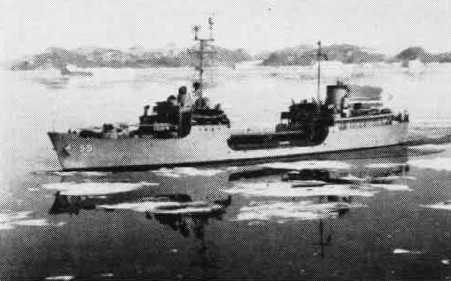U.S.S. Nespelen (AOG-55)

Career
![]() Name: USS Nespelen (AOG-55) Builder: Cargill Inc. Laid down: 28
August 1944 Launched: 10 April 1945 Commissioned: 9 August 1945 Struck: 1
July 1975 Fate: Sold for scrap on 24 March 1976 General characteristics
Class and type: Patapsco-class gasoline tanker Displacement: 4,335
long tons (4,405 t) full load Length: 310 ft 9 in (94.72 m) Beam: 48 ft 6 in
(14.78 m) Draft: 15 ft 8 in (4.78 m) Propulsion: 4 × General Electric
diesel-electric engines, twin shafts, 3,300 hp (2.5 MW) Speed: 15 knots
(17 mph; 28 km/h) Capacity: 2,210 long tons (2,250 t) deadweight (DWT)
Complement: 124 officers and men Armament: • 4 × 3"/50 caliber guns
Name: USS Nespelen (AOG-55) Builder: Cargill Inc. Laid down: 28
August 1944 Launched: 10 April 1945 Commissioned: 9 August 1945 Struck: 1
July 1975 Fate: Sold for scrap on 24 March 1976 General characteristics
Class and type: Patapsco-class gasoline tanker Displacement: 4,335
long tons (4,405 t) full load Length: 310 ft 9 in (94.72 m) Beam: 48 ft 6 in
(14.78 m) Draft: 15 ft 8 in (4.78 m) Propulsion: 4 × General Electric
diesel-electric engines, twin shafts, 3,300 hp (2.5 MW) Speed: 15 knots
(17 mph; 28 km/h) Capacity: 2,210 long tons (2,250 t) deadweight (DWT)
Complement: 124 officers and men Armament: • 4 × 3"/50 caliber guns
• 12 × 20 mm AA guns
1940s
After shakedown off Galveston, Texas, the new gasoline tanker took on a load
of diesel fuel and departed for Cuba. She arrived at Guantanamo Bay on 26
September 1945, unloaded her cargo, and proceeded to Havana. Remaining in
Cuban waters, she made four shuttle trips between Havana and Guantanamo Bay
between 4 October and 11 November. Then Nespelen made a turn-about trip to
Port Arthur, Texas, returning to Guantanamo Bay on 22 November with a full
load of motor gasoline. Following a short repair period, she steamed to
Aruba for a cargo of diesel oil and then proceeded to Boston.
Arriving Boston on 9 December, she was drydocked for repairs to her
auxiliary engines and port propeller. She then steamed to Newfoundland,
reaching Argentina on Christmas Day. She operated in the Newfoundland area
until sailing on 26 February 1946 for Bermuda, stopping en route at
Melville, Rhode Island and Bayonne, New Jersey to load diesel oil to be
delivered to the U.S. Navy Base, St. George, Bermuda. After a three-day
stop-over she returned to Newfoundland via Marcus Hook, Pennsylvania. For
the next year and one half she carried gasoline and diesel oil between
Argentia and St. Johns, Newfoundland; Melville, Rhode Island; Aruba; and
Trinidad.
Remaining with Service Force, Atlantic Fleet, she continued operations tip
and down the Atlantic seaboard. Then duties took Nespelen to such ports as
Narsarssuak, Greenland; Terceira Island in the Azores; Lake Melville,
Labrador; Casablanca, French Morocco; Thule, Greenland; Halifax, Nova
Scotia; Godthab, Greenland and Resolute Bay in addition to numerous east
coast ports.
1950s
In November 1952 orders arrived sending the oiler to the Mediterranean and
the United States Sixth Fleet. She visited such ports as Malta; Bari and
Naples, Italy; Casablanca and Marseilles.
On 3 January 1953 Nespelen slipped her moorings and continued on to
Golfe-Juan and then sailed to Tripoli, Oran, Naples, Augusta Bay, Sicily and
back to Tripoli where she moored on 8 February. She operated out of Tripoli
until 19 March at which time she got underway for Bari; Phaleron Bay,
Greece; Larnaca, Cyprus; Malta and Gibraltar, her last stop in the
Mediterranean before sailing 14 April 1953 for the United States, arriving
Norfolk on the 26th. She steamed up and down the East Coast, travelling as
far north as Thule, Greenland and as far south as Bermuda until February
1954. She was then assigned another tour of duty in the Mediterranean and
revisited the previous ports and such new ones as Iskenderun, Turkey; Genoa
and Naples, Italy; Sete and St. Louis du Rhone, France before heading home
in June.
In January 1955 she departed Norfolk for Gibraltar and a third tour of duty
with the 6th Fleet which lasted until May, when she returned to the United
States and Norfolk. In the fall and winter of 1955–1956, Nespelen
participated in Operation Deep Freeze, a scientific expedition into the
frozen wastes of Antarctica.
In the years that followed Nespelen resumed her pattern of operations:
alternating duty carrying fuel from ports in the Caribbean and on the East
Coast to bases in the far northern Atlantic with deployments in the
Mediterranean supporting the 6th Fleet. In the summer of 1969 she headed
back to the volatile Mediterranean to support American sea strength through
the end of the year.
Fate
Nespelen was laid up in the Reserve Fleet at Navel Amphibious Base Little
Creek, Virginia, and struck from the Naval Vessel Register on 1 July 1975.
Transferred to the Maritime Administration for disposal, she was sold on 24
March 1976 to Union Minerals & Alloys for scrapping.